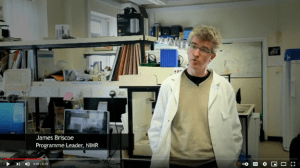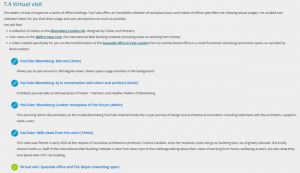Kerstin Sailer (The Bartlett School of Architecture)
Asynchronous Submission
Replacing first-hand experiences made through fieldtrips with an equivalent remote activity is a tremendous challenge. Normally, I take my postgraduate students at the Bartlett School of Architecture into a different building every week, where we observe and discuss spatial layouts, design choices and how they impact user behaviours on the ground. This forms the basis of a bi-weekly blog post, which then feeds into the final assessment.
In the absence of these weekly fieldtrips, I collected and curated a list of short online videos, many of them sourced from YouTube. I also asked students in week 3 to film their own videos, wherever they were based, or curate their own list of links on a building of their choice. Here I want to share my experiences and offer reflections on what went well and what could inspire future practice, once in-person teaching can be resumed.
Understanding case studies through first-hand experiences is an excellent way for students to learn. In architecture as a discipline, fieldtrips are a common pedagogical device, allowing students to experience the built environment in a certain place together with their peers and tutors, discussing aspects of architectural or urban design while being immersed in the situation. ‘Students making connections out to the world’ is one of the dimensions of UCL’s Connected Curriculum framework, and arguably, connecting students to real-life examples of built space provides ample learning opportunities, as argued by Sailer and Kendall in their book chapter ‘Contextualising and Connecting Learning’.
The remote challenge posed by Covid-19
The ongoing and critical situation with the Covid-19 pandemic in early autumn 2020 meant that UCL decided that all teaching for term 1 of the academic year 2020/2021 would be delivered remotely. While a theory-based seminar is reasonably easy to transform to an asynchronous set of learning activities, for example by adopting a flipped classroom approach, replacing first-hand experiences made through fieldtrips with an equivalent remote activity is a tremendous challenge. So, in this blog post I am reporting how I strategically adapted my teaching and what I’ve learnt in the process.
From fieldtrips to YouTube
Before going into the pandemic reality of remote delivery, let me explain how my teaching practice looks like in a standard year for some context. Normally, I take my group of 20-25 postgraduate students enrolled in the Master’s programme ‘Space Syntax: Architecture and Cities’ at the Bartlett School of Architecture into a different building every week, where we observe and discuss spatial layouts, design choices and how they impact user behaviours on the ground. This forms the basis of a bi-weekly blog post, asking students to reflect on one aspect of the visit and connect their experience to theories featured in the lecture. The blogs are peer-reviewed by the class and then feed into the final assessment, in which students select their three best texts and revise them for a report based on formative tutor feedback.
The way the fieldtrips connect with the assessment meant that I could not skip the building visits without completely changing my way of assessing.
Thus, in the absence of these weekly fieldtrips and after long deliberations, I decided for an approach of virtual visits, i.e. I collected and curated a list of short online videos, many of them sourced from YouTube. You might not think of YouTube as a resource for scholarly purposes, but there is a surprising wealth of material of buildings and how people experience them. I’ve discovered that some buildings such as the Francis Crick Institute, a large biomedical research lab near St Pancras which I always visit with my students has its own YouTube channel, including videos describing how scientists moved from their old labs to the Crick Institute, thus offering insights we could not have gained in a traditional building visit.
Screenshot from a video of science labs before moving into the Francis Crick Institute. Source: https://www.youtube.com/watch?v=awIEHJK6Ujo
There is an interesting YouTube sub-genre of people describing ‘A day in the life of…’ showing their workplaces and work patterns, including contributions by UCL students such as one student taking us through the experience of working in the UCL main library. Office buildings are also quite well covered on YouTube, as are hospitals. Needless to say perhaps that videos had to be quite carefully curated and selected, not just for appropriate content, but also in order to focus on the aspects that I value most from the fieldtrip experience of being in a building, such as seeing everyday patterns of usage and behaviours rather than staged interviews, for example.
Multiplying voices
I complemented the YouTube selection by four additional means, thus diversifying the offer of material to watch:
- In early autumn, as buildings in the UK were partially open to visitors, I filmed a series of walkthroughs myself, for example a tour of UCL Campus, a visit to the British Library and my experience of a distanced visit to the British Museum ground floor exhibitions.
- I commissioned my PhD students to film a view on buildings they are familiar with, or have researched; for example, my PhD student Ahmed Zaky Fouad filmed his take on the UCL Student Centre for me and my MSc students.
- I asked building users themselves to film their places of work and study for us. Secondary school students of UCL Academy participated in this activity and walked through their school with their mobile phones, filming their favourite places and explaining how the school building worked for them. This footage was annotated by the Co-Principal of the school highlighting different perspectives.
- In week three of the ten-week programme I paused the visits I scheduled for my students and asked them instead to curate a virtual visit by themselves, either by collecting source material from the internet, or by going out into a building of their choice.
The image below shows a snapshot from my Moodle page, showcasing how the final selection of different videos was presented to the students in an annotated list.
Turning students to contributors
Switching roles and asking students to produce their own material for a visit went really well and was a satisfying experience both for me as tutor, but also for the students. I received a very diverse collection of visits from students, ranging from a list of online videos of St Paul’s Cathedral to students walking through actual buildings and filming themselves. One student provided a thoughtful video of her tour through Tate Modern for example, reflecting on the experience of distancing and changes in routes. Other students introduced us to the stunning Municipal Headquarters of Greater Mumbai, the Changzhou Library, the Regenstein & Mansueto Library in Chicago, the National Gallery of Modern Arts in Bangalore, or Air Raid Shelters in Singapore.
Turning students to contributors allowed not only to multiply voices, perspectives and possible buildings we could all view and experience – capitalising on the fact that my group of students comes from all over the world and some were still based in their home countries – it also gave the students an understanding of how to produce (low-tech) content for audiences and how to tell the story of a building.
Multiplicities of space – advantages and challenges
With the approach described above, the class was able to experience many more different spaces and buildings in parallel than a traditional face-to-face fieldtrip to a series of physical buildings in London would have allowed. This has obvious advantages, such as broadening the horizon of all participants in the class (including my own!) and contributing to the initiative to decolonise the curriculum. The available multiplicities of space gave students more options to choose from for their own blog writing and it was particularly heart-warming to see how students used each other’s content to push their own reflections and thinking. At the same time, it introduced challenges, both for me as a tutor and the students. Some struggled with too much choice; others found it hard to peer-review buildings they had never seen. For me as a tutor it became more difficult to bring different viewpoints together, so that as a class we moved forward based on the same material.
Experiences and reflections
Finally, I want to summarise my experiences and offer reflections on what went well and what could inspire future practice, once in-person teaching can be resumed.
In my view, the virtual visit programme went much more smoothly than I had anticipated (and feared). I was pleasantly surprised how deeply students were able to engage with the material on the whole and understand buildings in use that they have never seen in real life. One particular issue arises from of the angle of the camera and understanding the building and sequence of spaces holistically. In a virtual visit, viewers can only see what has been curated by the producer; they cannot turn around and take in the ‘other’ view that a physical space experience provides naturally. Therefore, the experience of a virtual visit is more channelled and possibly narrower. It might also be tempting to take narratives and how they are told in a video at face value. It takes an extra effort to abstract from the curated viewpoints presented in a video and to critically reflect whether one agrees with the perspective taken. The embodied experience of being in a building, being able to look around oneself, being able to query and engage with users first-hand, being able to pick up nuances remains difficult to replace.
Having said that, some elements of my virtual visit experience are worth retaining for future practice, I believe, no matter whether 2021-2022 will be held face-to-face, remotely or in some kind of blended learning mode. The diversity of buildings we have seen and discussed in class is something I still cherish; likewise, the experience of students producing content provides a richness of learning experience for everyone that I would not like to miss in the future. On the other hand, I cannot wait to meet my students face-to-face again and return to some of my favourite London’s buildings.


This was a great insight into one way to use flipped learning and turning students into contributors. I can imagine the engagement increased hugely when you did this. As an IOE student and teacher, I am looking for ways to expand my flipped learning ideas and give my pupils more agency so this has given me food for thought. Thank you.